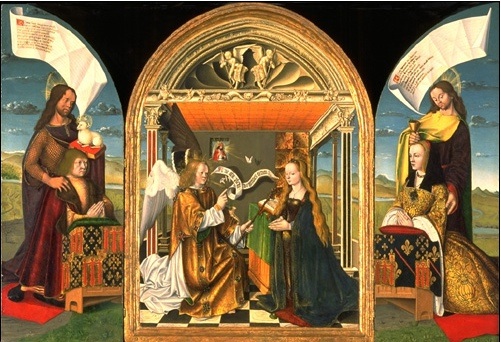Master of the Latour d'Auvergne Triptych (French, active about 1490-1500)

http://ncartmuseum.org/collections/highlights/european/french/before1760/001_lrg.shtml
Master of the Latour d'Auvergne Triptych (French, active about 1490-1500)
The Annunciation with Saints and Donors, called the Latour d'Auvergne Triptych, about 1497
Oil on panel, center 26 11/16 x 19 3/8 in. (67.8 x 49.3 cm.), wings (each) 26 5/8 in. (67.7 cm.) in height, left wing is 9 1/2 in. (24.2 cm.) wide, right wing is 9 5/8 in. (24.5 cm). wide
Gift of the Samuel H. Kress Foundation, 60.17.61
The subject of this three-panel painting, or triptych, is the angel Gabriel's annunciation to the Virgin that she is to be the mother of Christ. His words to the Virgin are abbreviated in Latin on the scroll between them, "Ave gra[tia] plena dominus tecum" (Hail [Mary], full of grace, the Lord is with thee).
The wings of the triptych close like shutters to protect the painting. They bear the likenesses of the donors of the work, the Count and Countess of Latour d'Auvergne. Their names Jean and Jeanne are the French equivalents of John and therefore link them with their patron saints. On the left wing John the Baptist wears a hair shirt that is a reminder of his sojourn in the wilderness and holds a miniature lamb that refers to his pronouncement, "Behold the Lamb of God." On the right wing John the Evangelist is identified by his chalice filled with poison, represented by the tiny dragon inside.
French verses on the banners above each donor offer prayers to the Virgin on their behalf. The scroll on the left refers to Gabriel's annunciation and prays for the salvation the Count. The verses on the right request the blessing of children for the Countess. Since the couple married in 1495 and are believed to have had their first child in 1498, the inscription dates the painting to about 1497.
The painting is from the beginning of the Renaissance in France. The positioning of the figures with a landscape background that extends across all three panels displays the Renaissance interest in portraying Biblical figures in a natural setting. The hills and vegetation seem to indicate precisely both the locality of Auvergne and the season of the annunciation, March 25. Hallmarks of the Renaissance style are the recession into space of the landscape and the architecture and the shadows carefully painted on the wall behind the dove and the angel's scroll. Architectural details of the columns and capitals show that the artist had some familiarity with Italian Renaissance architecture, or at least engravings of it. Medieval symbols that survive into this period include the Holy Spirit entering the room in the form of a dove, the gilded rays of light emanating from the tiny figure of God the Father, and the white lilies of purity associated with the Virgin.
There is a remarkable attempt at realism in the figures as well as in the landscape. The faces of the Count and Countess appear to be true likenesses, and those of the Virgin and the angel seem closer to observed models than to idealized conceptions. While the anatomy of the figures is not completely successful, the size and heaviness of the hands of the Virgin display the efforts of the painter to reproduce hands as he had seen them. A mallard duck is clearly the model for the markings on the angel's wings.
The desire expressed on the scroll for a child was fulfilled. Their daughter married a member of the illustrious Medici family of Florence. Her own daughter successfully returned to France as the wife of the future King Henri II. Known as Queen Catherine de Medici, she played a dominant role in the French politics and culture of her time.
The triptych is also interesting for its history. Despite Flemish and Italian influences, the style of the painting seems to indicate that the work is a rare example of French provincial painting of the late fifteenth century, probably painted locally for the owners. An eighteenth-century inscription painted in gold on the backs of the shutters and another one written on paper and attached to the back of the central panel contribute to an unusually complete history of its ownership. After the Count's death the Countess kept the painting in her castle in Vic-le-Comte. She later bequeathed it to the Franciscan monks of that town, who retained possession of it until 1703 when it was returned to the Latour d'Auvergne family. After a long period of existence in its region of origin, the whereabouts of the painting in more recent years are obscure except for a sale in the 1870s. In 1957 the Samuel H. Kress Foundation acquired the work and subsequently donated it to the Museum.


0 Comments:
Enregistrer un commentaire
<< Home